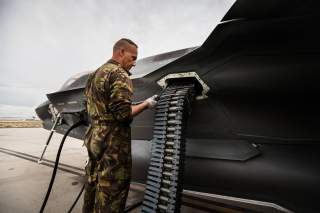$1,000,000,000,000 F-35 Stealth Fighter: 873 Software Flaws and 13 'Must-Fix' Issues
The F-35 Joint Strike Fighter reportedly still doesn’t work right, according to the latest annual report from the Pentagon’s chief weapons-tester.
The F-35 Joint Strike Fighter reportedly still doesn’t work right, according to the latest annual report from the Pentagon’s chief weapons-tester.
Anthony Capaccio at Bloomberg got an early look at the report from Robert Behler, Director, Operational Test & Evaluation. Behler’s report cites 873 software flaws related to the F-35 plus 13 “must-fix” issues, including problems with the 25-millimeter gun on the U.S. Air Force F-35A model.
With regard to the gun, Behler’s office “considers the accuracy, as installed, unacceptable” due to “misalignments” in the gun’s mount, Capaccio quoted the report as saying.
None of the problems in the DOT&E report actually are new, according to Capaccio, but they do underscore the difficulty Lockheed Martin and the F-35’s sponsor governments have had in developing the plane.
Trade publication Defense News in early June 2019 revealed lingering flaws in the F-35’s design. At high angles of attack, the F-35B and the carrier-compatible F-35C have a tendency to depart from controlled flight, Defense News reported.
“Specifically, the Marine short-takeoff-and-vertical-landing variant and the Navy’s carrier-launched version become difficult to control when the aircraft is operating above a 20-degree angle of attack, which is the angle created by the oncoming air and the leading edge of the wing,” Defense News explained.
The Pentagon wants Lockheed to fix the 13 most-critical problems before the company starts work on the JSF’s latest Block 4 software.
The 873 software bugs that DOT&E listed in the recent report actually represent an improvement. The test office in late 2018 cited 917 flaws in the F-35’s code.
The F-35, which first flew in production form in 2006, is on track to become one of the world’s most numerous warplanes. Lockheed so far has delivered nearly 500 F-35s in three models: the conventional F-35A, the vertically-landing F-35B and the big-wing F-35C for aircraft-carrier operations.
The U.S. Air Force alone plans to buy as many as 1,700 F-35As. The U.S. Navy and Marine Corps together plan to purchase more than 600 F-35Bs and Cs. Foreign customers such as the United Kingdom, Australia, Japan and South Korea have added hundreds of F-35s to Lockheed’s order book.
The F-35 program over its decades-long lifespan could cost the United States alone more than a trillion dollars for development, acquisition and support. Each airframe costs around $100 million.
The F-35 has entered service, and even flown in combat, before Lockheed has completed the plane’s development.
The Israeli air force claimed it was the first to fly F-35s in combat. Tel Aviv in May 2018 announced it deployed the radar-evading jet on two fronts. The Israeli government circulated a photo of an Israeli F-35A flying over Beirut in Lebanon during the daytime, strongly implying the fighter struck targets in Lebanon. Israeli warplanes also frequently operate over Syria.
U.S. Marine Corps F-35Bs in September 2018 conducted an air strike in support of what the U.S. Navy described as "ground clearance operations" in Afghanistan. The U.S. Air Force flew its own F-35As in combat for the first time over Iraq in April 2019.
The Navy is still working up its F-35C squadrons for their first front-line cruise aboard an aircraft carrier, currently scheduled for 2021.
The Royal Air Force flew its F-35Bs in combat for the first time in 2019, over Syria. The U.K. F-35B’s sortie rate in wartime conditions was no better than the sortie rate the remnant fleet of 1980s-vintage Tornado fighter-bombers achieved in the years preceding the type’s 2019 retirement.
The eight Tornadoes the RAF deployed to Cyprus for missions over Syria as recently as 2015 managed two, two-ship sorties a day, each lasting six to eight hours, according to Financial Times.
Lingering problems with the F-35 are unlikely to slow the JSF program. The U.S. Congress habitually adds F-35s to the Pentagon’s own annual requests for the type. More and more governments are placing orders for F-35s.
Lockheed spokesperson Brett Ashworth told Capaccio that the F-35 “continues to mature and is the most lethal, survivable and connected fighter in the world.”
“Reliability continues to improve, with the global fleet averaging greater than 65-percent mission-capable rates and operational units consistently performing near 75 percent,” Ashworth added.
David Axe serves as Defense Editor of the National Interest. He is the author of the graphic novels War Fix, War Is Boring and Machete Squad.

